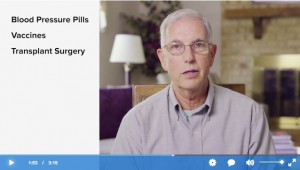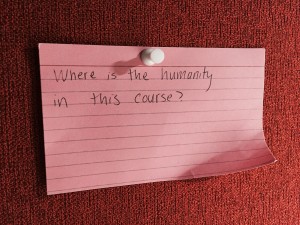
So, you’re putting your online course together and you realize that there are already videos on YouTube for all the topics you’re covering. You say to yourself, “Why even take the time to create my own videos and reinvent the wheel? I could save so much time and effort! I’d just be a talking head, anyway.” Before you make your decision, consider the following two reasons why it may be a good idea to create at least some of your own media.
Reason #1: Students Value Content You Create
Students place value in instructor-created media content (videos, webinars, narrated presentations, etc). The absence of instructor-created media is something we read about in course evaluations. For example, I recently worked with an instructor to redesign the course Statistics for Health and Wellness Managers. For the first offering, the instructor carefully selected a library of freely available videos that aligned with each lesson’s outcomes. In course evaluations, students pointed out that there were only YouTube videos in the course and no instructor-created media content.
Before the next offering, we decided to create some videos featuring the instructor. The instructor created a short video for each lesson using the following framework:
- Definition: conceptually, what the unit is about
- Purpose statement: why it’s important
- Health and wellness example
- Application example
We are not sure about the efficacy of the videos when it comes to student performance. I look forward to seeing if, after another semester, there is improvement in overall performance again. As far as student satisfaction goes, we haven’t gotten any evaluations from students that say they are dissatisfied with the YouTube videos, and, according to the instructor, there was some positive feedback—which is an improvement. Going forward, student satisfaction derived from instructor-created media content is something I will share with instructors I’m consulting with.
Reason #2: The Human Element

I penned “Where is the humanity in this course?” on a notecard and pinned it to my bulletin board at work after an inspiring day of doing a video shoot for the course Dynamics of Worksite Wellness Evaluation and ROI. I was conversing with the instructor about why people cared about the subject. We got into a conversation about how you can present factual information to students, but the real challenge (and real reward) of designing a course is finding the heart and soul of a topic—why do people care about this, and why does it matter? For example, by telling a story to your students you can get to the heart of the matter. For me, it’s definitely a consideration in course design, and a lot of times this comes through in the form of some kind of media.
Your multimedia can also add an unquantifiable “feel good” quality for students that often isn’t taken into consideration. Think of all the ways you can add a human touch to your course with multimedia. These could be as short as a one-minute video example you shoot with your iPhone, or a more involved project you work together with an instructional designer on. Keep the human element in mind when you’re deciding on the pros and cons of including videos, presentations, digital storytelling, or any other type of multimedia that you might create (or work together with an instructional designer to create).
What are your reasons and motivations for creating multimedia? I’d love to hear from your experiences. Was it worth it to spend the time to create something new? What value do you and your students see in your videos, presentations, audio recordings, or other multimedia?
For Further Reading
If you’d like to read a study done about multimedia and the effect on student engagement, check out Effect of Instructor-Personalized Multimedia in the Online Classroom.
For a more in-depth look at video in online courses, read What Makes an Online Instructional Video Compelling? The section titled “Instructor Presence” supports the idea of videos as a boon to adding a touch of humanity to your course.
Cheryl says
Excellent post!
I agree that if at all possible, create new media for students to use to meet their learning objectives. You can also you the ASSURE Model to decide whether to re-use content and media. The “U” in the ASSURE Model is to Utilize Resource. If when planning your curriculum, content, resources, technology and media, review whether the existing media and content are right for each other. It comes down to preparing the resources, the environment and the learners and providing the right learning experience.
Again, a very good read.
Kristin Barnes says
Thanks for your comment and insight, Cheryl!
No matter what model you’re using (and there are lots of them), I agree that it’s really important to choose resources that fit- what experience are you creating for your students and why? We might have some cool video equipment and dream of making what we want to, but if it doesn’t fit then we really, as a design team, have to question that. This is a key difference between design for learning and making art, I suppose!
Designing a course is all about choices and providing that “right learning experience” as you said. Here I really wanted to show that a couple of attributes of videos “starring” you could include that warm fuzzy feeling – and considering the learner’s emotions are an important part of course design for me – an important part of defining the “right” experience. I think I might have some inspiration for another post with that claim 🙂